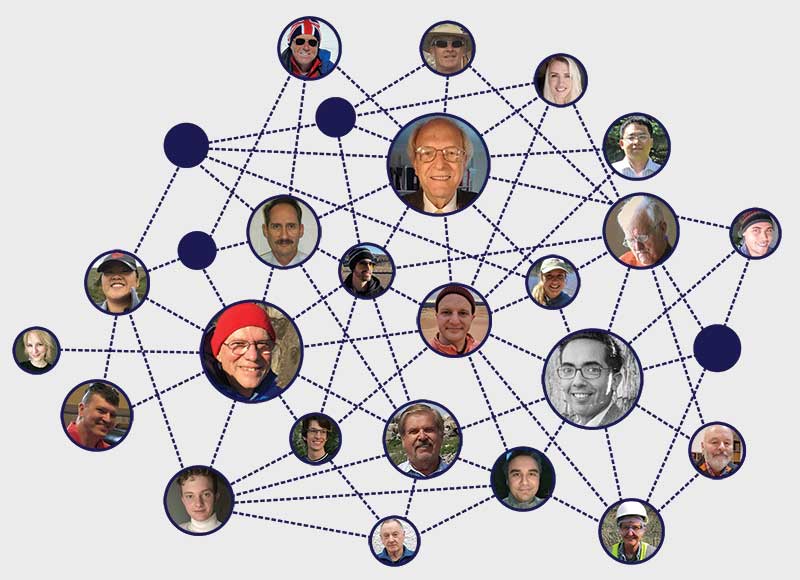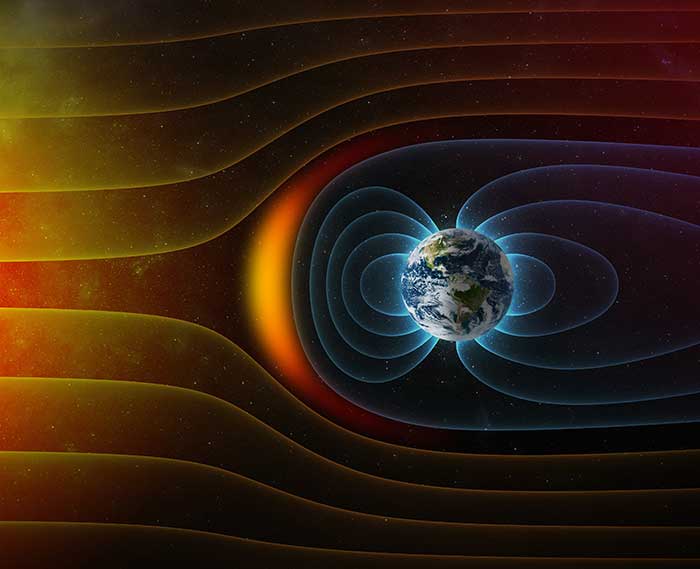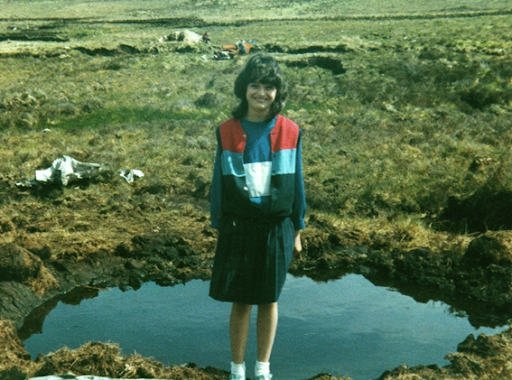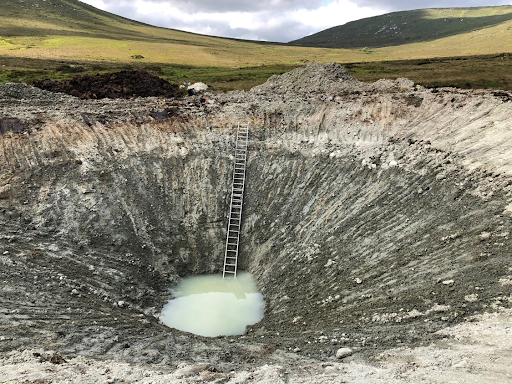MQN Guide
Much like GPS guides one along a pathway to a destination, we present 8 “waypoints” of relevant information to guide readers through the overall concept.
Peer Reviewed Science
Is there solid science supporting Magnetized Quark Nuggets as a candidate for dark matter?
Dark Matter
Tell me about dark matter and the Standard Model of Cosmology.
Normal Matter and Quarks
Tell me about normal matter, quarks, and the Standard Model of Particle Physics.
Quark Nuggets and Magnetar Pulsars
What do Magnetar Pulsars have to do with Quark Nuggets?
Aggregation vs. Decay
Since Quark Nuggets are not observed in high-energy accelerator experiments, aren’t they excluded as stable particles and therefore cannot be dark matter?
Detection
If MQNs exist, how can they be detected and have they been detected?
Capture
Since MQNs should be indestructible, can their passage through the Sun slow them down enough to make them collectable?
Applications
If MQNs can be collected, what applications might they enable?

People Make Progress
6a. Detection with non-meteorite impacts
MQNs can be detected by their interaction with matter through their ~ trillion-tesla magnetic field. An MQN passing through dense matter at high velocity forms a magnetopause at which the compressed magnetic field pressure equals the flowing particle pressure — just as Earth’s magnetopause is formed by the solar wind from the sun and illustrated by the graphics above and below.

The magnetopause is thousands of times larger than the geometric size of the nuclear-density MQN, so the energy deposited per unit length is correspondingly larger.
We have shown the energy transfer between matter and the MQN magnetopause can be very large. MQN impacts with Earth are consistent with non-meteorite craters reported approximately annually in the press. For example
- A 12-m diameter crater was reported near Managua, Nicaragua, on September 6, 2014. [Cooke, W. Did a meteorite cause a crater in Nicaragua? and CNN.com]
- Another event occurred on July 4, 2015, at the Salty Brine Beach in Rhode Island, USA. [Shapiro, E., Cathcart, C. & Donato, C. Bomb squad, ATF investigating mysterious explosion at Rhode Island beach]
- On February 6, 2016, an event occurred in Tamil Nadu, India. [Hauser, C. That wasn’t a meteorite that killed a man in India, NASA says]
We have excavated a non-meteorite crater formed in 1985 in a peat bog in County Donegal, Ireland. Six characteristics of the crater and subsurface structure were consistent with MQN impact. We have found no alternative explanation.


Photo of the non-meteorite crater shortly after the impact in May of 1985 on top and during excavation to the bedrock in July 2019 on bottom. Photo on top was taken by investigating Garda Mick Galligan and is used by permission of his daughter, Ms. Emer Galligan McMullen shown in the photograph.
6b. Detection by rotating magnetic field
We also found that MQNs rotate as they pass through matter and can spin up to millions of revolutions per second (Nature.com). They can be detected through the effects of their rotating magnetic field after slowing down by passing nearly tangentially through Earth (Universe). Similar episodic events have been reported[1] by Soviet Naval captains.
In addition to making large glowing and magnetically levitated observables, rotating MQNs push aside material. Of course, MQNs at sea leave no lasting impression to be studied. However, MQNs over conducting ground can form lasting structures that permit their mass to be estimated. We have shown that an event reported in the Proceedings of the Royal Society[2] is consistent with a million-kilogram rotating MQN that lasted ~ 20 minutes and left at least three trenches in a peat bog, including a 25-meter diversion of a stream from its course record in a previous ordnance survey.

(Top) Video walk-through of 25-meter long diversion of the stream during the 1868 event after the Council excavated the blockage in the 1980s and restored the stream to its original path, as recorded in the 1863 Ordnance Survey map. We cut out the vegetation obscuring the path before recording the extent of the approximately 2-meter-by-2-meter-by-25-meter excavation by the "globe of fire" in approximately 25 seconds, as reported by Fitzgerald.
(Bottom) Contour map of the site constructed from the survey and field notes. Solid lines: surface level. Long dashes: the bottom of the ball-lightning-cut channel at -1.2 ± 0.25 m level. Short dashes: the bottom of the stream, as cut by the County Council in the 1980s, at the -1.9 ± 0.2 m level. Orientation to north is approximate.
6c. Detection by radiofrequency emissions
These and similar episodic events support the MQN dark-matter hypothesis, but more systematic data are needed to test the theory. Since rotating magnetic fields radiate electromagnetic energy, they can be detected by their radiofrequency emissions after passing through Earth’s atmospheres and emerging into the outer magnetosphere. Detection with three satellites in the outer magnetosphere appears to be the most promising way to make systematic observations (Nature.com).

Image illustrates architecture of three satellites in magnetosphere (purple) monitoring RF emissions (gold) generated by MQN transit (red arrow).
MQN Guide
Much like GPS guides one along a pathway to a destination, we present 8 “waypoints” of relevant information to guide readers through the overall concept.
Peer Reviewed Science
Is there solid science supporting Magnetized Quark Nuggets as a candidate for dark matter?
Dark Matter
Tell me about dark matter and the Standard Model of Cosmology.
Normal Matter and Quarks
Tell me about normal matter, quarks, and the Standard Model of Particle Physics.
Quark Nuggets and Magnetar Pulsars
What do Magnetar Pulsars have to do with Quark Nuggets?
Aggregation vs. Decay
Since Quark Nuggets are not observed in high-energy accelerator experiments, aren’t they excluded as stable particles and therefore cannot be dark matter?
Detection
If MQNs exist, how can they be detected and have they been detected?
Capture
Since MQNs should be indestructible, can their passage through the Sun slow them down enough to make them collectable?
Applications
If MQNs can be collected, what applications might they enable?

People Make Progress
6a. Detection with non-meteorite impacts
MQNs can be detected by their interaction with matter through their ~ trillion-tesla magnetic field. An MQN passing through dense matter at high velocity forms a magnetopause at which the compressed magnetic field pressure equals the flowing particle pressure — just as Earth’s magnetopause is formed by the solar wind from the sun and illustrated by the graphics above and below.

The magnetopause is thousands of times larger than the geometric size of the nuclear-density MQN, so the energy deposited per unit length is correspondingly larger.
We have shown the energy transfer between matter and the MQN magnetopause can be very large. MQN impacts with Earth are consistent with non-meteorite craters reported approximately annually in the press. For example
- A 12-m diameter crater was reported near Managua, Nicaragua, on September 6, 2014. [Cooke, W. Did a meteorite cause a crater in Nicaragua? and CNN.com]
- Another event occurred on July 4, 2015, at the Salty Brine Beach in Rhode Island, USA. [Shapiro, E., Cathcart, C. & Donato, C. Bomb squad, ATF investigating mysterious explosion at Rhode Island beach]
- On February 6, 2016, an event occurred in Tamil Nadu, India. [Hauser, C. That wasn’t a meteorite that killed a man in India, NASA says]
We have excavated a non-meteorite crater formed in 1985 in a peat bog in County Donegal, Ireland. Six characteristics of the crater and subsurface structure were consistent with MQN impact. We have found no alternative explanation.


Photo of the non-meteorite crater shortly after the impact in May of 1985 on top and during excavation to the bedrock in July 2019 on bottom. Photo on top was taken by investigating Garda Mick Galligan and is used by permission of his daughter, Ms. Emer Galligan McMullen shown in the photograph.
6b. Detection by rotating magnetic field
We also found that MQNs rotate as they pass through matter and can spin up to millions of revolutions per second (Nature.com). They can be detected through the effects of their rotating magnetic field after slowing down by passing nearly tangentially through Earth (Universe). Similar episodic events have been reported[1] by Soviet Naval captains.
In addition to making large glowing and magnetically levitated observables, rotating MQNs push aside material. Of course, MQNs at sea leave no lasting impression to be studied. However, MQNs over conducting ground can form lasting structures that permit their mass to be estimated. We have shown that an event reported in the Proceedings of the Royal Society[2] is consistent with a million-kilogram rotating MQN that lasted ~ 20 minutes and left at least three trenches in a peat bog, including a 25-meter diversion of a stream from its course record in a previous ordnance survey.

(Top) Video walk-through of 25-meter long diversion of the stream during the 1868 event after the Council excavated the blockage in the 1980s and restored the stream to its original path, as recorded in the 1863 Ordnance Survey map. We cut out the vegetation obscuring the path before recording the extent of the approximately 2-meter-by-2-meter-by-25-meter excavation by the "globe of fire" in approximately 25 seconds, as reported by Fitzgerald.
(Bottom) Contour map of the site constructed from the survey and field notes. Solid lines: surface level. Long dashes: the bottom of the ball-lightning-cut channel at -1.2 ± 0.25 m level. Short dashes: the bottom of the stream, as cut by the County Council in the 1980s, at the -1.9 ± 0.2 m level. Orientation to north is approximate.
6c. Detection by radiofrequency emissions
These and similar episodic events support the MQN dark-matter hypothesis, but more systematic data are needed to test the theory. Since rotating magnetic fields radiate electromagnetic energy, they can be detected by their radiofrequency emissions after passing through Earth’s atmospheres and emerging into the outer magnetosphere. Detection with three satellites in the outer magnetosphere appears to be the most promising way to make systematic observations (Nature.com).

Image illustrates architecture of three satellites in magnetosphere (purple) monitoring RF emissions (gold) generated by MQN transit (red arrow).
6a. Detection with non-meteorite impacts
MQNs can be detected by their interaction with matter through their ~ trillion-tesla magnetic field. An MQN passing through dense matter at high velocity forms a magnetopause at which the compressed magnetic field pressure equals the flowing particle pressure — just as Earth’s magnetopause is formed by the solar wind from the sun and illustrated by the graphics above and below.

The magnetopause is thousands of times larger than the geometric size of the nuclear-density MQN, so the energy deposited per unit length is correspondingly larger.
We have shown the energy transfer between matter and the MQN magnetopause can be very large. MQN impacts with Earth are consistent with non-meteorite craters reported approximately annually in the press. For example
- A 12-m diameter crater was reported near Managua, Nicaragua, on September 6, 2014. [Cooke, W. Did a meteorite cause a crater in Nicaragua? and CNN.com]
- Another event occurred on July 4, 2015, at the Salty Brine Beach in Rhode Island, USA. [Shapiro, E., Cathcart, C. & Donato, C. Bomb squad, ATF investigating mysterious explosion at Rhode Island beach]
- On February 6, 2016, an event occurred in Tamil Nadu, India. [Hauser, C. That wasn’t a meteorite that killed a man in India, NASA says]
We have excavated a non-meteorite crater formed in 1985 in a peat bog in County Donegal, Ireland. Six characteristics of the crater and subsurface structure were consistent with MQN impact. We have found no alternative explanation.


Photo of the non-meteorite crater shortly after the impact in May of 1985 on top and during excavation to the bedrock in July 2019 on bottom. Photo on top was taken by investigating Garda Mick Galligan and is used by permission of his daughter, Ms. Emer Galligan McMullen shown in the photograph.
6b. Detection by rotating magnetic field
We also found that MQNs rotate as they pass through matter and can spin up to millions of revolutions per second (Nature.com). They can be detected through the effects of their rotating magnetic field after slowing down by passing nearly tangentially through Earth (Universe). Similar episodic events have been reported[1] by Soviet Naval captains.
In addition to making large glowing and magnetically levitated observables, rotating MQNs push aside material. Of course, MQNs at sea leave no lasting impression to be studied. However, MQNs over conducting ground can form lasting structures that permit their mass to be estimated. We have shown that an event reported in the Proceedings of the Royal Society[2] is consistent with a million-kilogram rotating MQN that lasted ~ 20 minutes and left at least three trenches in a peat bog, including a 25-meter diversion of a stream from its course record in a previous ordnance survey.

(Top) Video walk-through of 25-meter long diversion of the stream during the 1868 event after the Council excavated the blockage in the 1980s and restored the stream to its original path, as recorded in the 1863 Ordnance Survey map. We cut out the vegetation obscuring the path before recording the extent of the approximately 2-meter-by-2-meter-by-25-meter excavation by the "globe of fire" in approximately 25 seconds, as reported by Fitzgerald.
(Bottom) Contour map of the site constructed from the survey and field notes. Solid lines: surface level. Long dashes: the bottom of the ball-lightning-cut channel at -1.2 ± 0.25 m level. Short dashes: the bottom of the stream, as cut by the County Council in the 1980s, at the -1.9 ± 0.2 m level. Orientation to north is approximate.
6c. Detection by radiofrequency emissions
These and similar episodic events support the MQN dark-matter hypothesis, but more systematic data are needed to test the theory. Since rotating magnetic fields radiate electromagnetic energy, they can be detected by their radiofrequency emissions after passing through Earth’s atmospheres and emerging into the outer magnetosphere. Detection with three satellites in the outer magnetosphere appears to be the most promising way to make systematic observations (Nature.com).

Image illustrates architecture of three satellites in magnetosphere (purple) monitoring RF emissions (gold) generated by MQN transit (red arrow).
MQN Guide
Much like GPS guides one along a pathway to a destination, we present 8 “waypoints” of relevant information to guide readers through the overall concept.
Peer Reviewed Science
Is there solid science supporting Magnetized Quark Nuggets as a candidate for dark matter?
Dark Matter
Tell me about dark matter and the Standard Model of Cosmology.
Normal Matter and Quarks
Tell me about normal matter, quarks, and the Standard Model of Particle Physics.
Quark Nuggets and Magnetar Pulsars
What do Magnetar Pulsars have to do with Quark Nuggets?
Aggregation vs. Decay
Since Quark Nuggets are not observed in high-energy accelerator experiments, aren’t they excluded as stable particles and therefore cannot be dark matter?
Detection (above)
If MQNs exist, how can they be detected and have they been detected?
Capture
Since MQNs should be indestructible, can their passage through the Sun slow them down enough to make them collectable?
Applications
If MQNs can be collected, what applications might they enable?


 Detection
Detection
